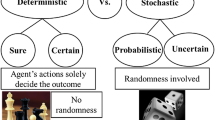Abstract
In this article we introduce the recessive gene model (RGM), as a tool in numerical function optimization with binary coded genetic algorithms (GAs). GAs are widely applied in many optimization problems, and usually their main setback is loss of diversity, leading to either evolutionary stagnation or premature convergence. The dual-gene system exploits local continuities in multivariable, multimodal functions, thereby ensuring optimal propagation and avoiding premature convergence. Our simulations show that the efficiency of RGM is superior to the usual analysis employing only dominant genes, that RGM performs better on small populations than the single dominant gene at the same computational cost, and that RGM occasionally performs the function of mutation.
Similar content being viewed by others
References
DE Goldberg (1989) Genetic algorithms in search, optimization and Machine Learning Addison-Wesley Reading
M Gen R Cheng (1997) Genetic algorithms and engineering design Wiley–Interscience New York
BD Fogel (1995) Evolutionary computation: toward a new philosophy of machine intelligence IEEE Press New York
DL Whitley (1993) Foundations of genetic algorithms 2 Morgan Kauffmann San Mateo
M Melanie (1997) An introduction to genetic algorithms MIT Press Cambridge
JH Holland (1995) Adaptation in natural and artificial systems: an introductory analysis with applications to biology, control and artificial intelligence MIT Press Cambridge
A Kiyuna H Kinjo K Kurata et al. (2005) ArticleTitleControl system design of multitrailer using neurocontrollers with recessive gene structure by step-up GA training (in Japanese) IEEJ Trans Electron Inf Syst 125 29–36 Occurrence Handle10.1541/ieejeiss.125.29
Hue X (1997) GAs for optimization: background and applications. Edinburgh Parallel Computing Centre, University of Edinburgh, Edinburgh
De Jong KA (1975) An analysis of the behavior of a class of genetic adaptive systems. Doctoral Dissertation, Department of Computer and Communications Sciences, University of Michigan, Ann Arbor
Schaffer JD, Caruana RA, Eshelman LJ, et al. (1989) A study of control parameters affecting online performance of genetic algorithms for function optimization. Proceedings of the 3rd International Conference on Genetic Algorithms. San Mateo, USA. Morgan Kauffmann, San Mateo
IlliGAL – the Illinois Genetic Algorithms Laboratory of David E. Goldberg. http://www.illigal.ge.uiuc.edu/
GEATbx – Genetic and Evolutionary Toolbox. www.geatbx.com
Author information
Authors and Affiliations
Corresponding author
Additional information
This work was presented in part at the 10th International Symposium on Artificial Life and Robotics, Oita, Japan, February 4–6, 2005.
About this article
Cite this article
Muhando, E., Kinjo, H. & Yamamoto, T. Enhanced performance for multivariable optimization problems by use of GAs with recessive gene structure. Artif Life Robotics 10, 11–17 (2006). https://doi.org/10.1007/s10015-005-0355-7
Received:
Accepted:
Issue Date:
DOI: https://doi.org/10.1007/s10015-005-0355-7




